View current page
...more recent posts
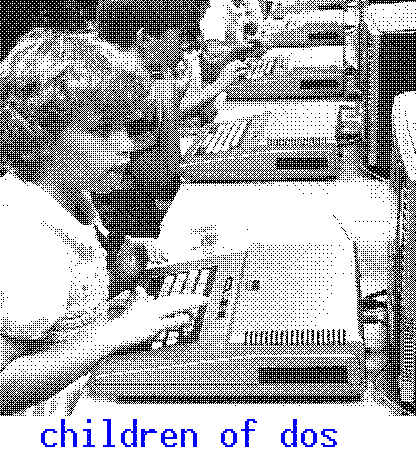
artist unknown - thanks to MBS for reminding me about that GIF scraper page for LiveJournal - there was so much good stuff I had to stop downloading so I could have a life -
"Amiable Floater" [mp3 removed]
Not that it matters, but the sound generation of this song is 100% analog. The computer was used only to trigger note on/off and velocity and to record and mix. The rest of it's voltages and filtering and a lot of layering. The genesis of it was that the drum machine I'm using has three tunable drums that can either be kicks or toms. I tuned them so the drum hits could be played like a bass line. The piece isn't really all that amiable--it gets a bit mysterious at the end during the "acid" part. The overall texture makes me think a little of Derrick May's work, which was the first techno music I really started studying. Not sure why exactly--kind of a jazzy feel?
It's a good headphone piece, I think.
Every couple of weeks the art and technology website Eyebeam reBlog invites a guest reBlogger to act as a combination curator, editor, and DJ, surfing and reposting noteworthy material from blog feeds. Paddy Johnson criticizes the tendency of the reBloggers of late to rely too much on known "tech news" sites (Make, Boingboing, et al) for recycled material. I agree with her, but then I would, because the practice violates my own self-declared "rules for reBlogging," posted at the end of my gig there in '04.
Generally speaking, there are entirely too many stories in the category Michael Bell-Smith calls Talking Refrigerators.
These are whimsical items about some engineering marvel, usually from a college robotics department or venture capital startup, that are at best consumerist PR and at worst the kind of ridiculous '50s gee whiz utopianism that we all should know by now has a down side and a dark side (just thinking of that nightvision video clip of the helicopter gunner blasting a wounded Iraqi soldier to hamburger--"squeeze the joystick, instant no soldier!").
Case in point: a recently reBlogged item offers a clip from a local news station about an alarm clock that rolls off your nightstand, forcing you to chase it across the floor until you wake up. Hey, that same fuzzy gear could be repurposed to make "rolling landmines" that follow you around till they blow your legs off! Less fluff, more stories about the world we live in I guess is what I'm hoping for.
And from the not-biting-the-hand-too-hard-that-feeds-me department, thanks to L.N.R., George Hotelling, Angus Galloway, Perry Lowe, Huong Ngo, Evan Roth, and David Jacobs for reBlogging me this year--you guys rule!
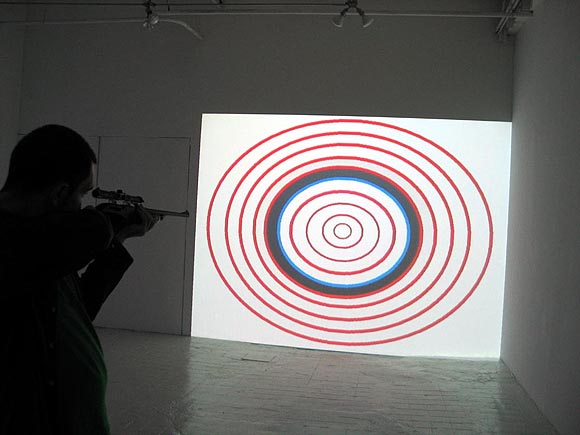
The critics (i.e., other artists) take aim. Referencing the interview Paddy Johnson did with Michael Bell-Smith and me, Joe McKay recently posted a comment that applies to the discussion about LCDs, CRTs, projections, and the like. (He didn't actually taking potshots in it--the remarks were some of the most supportive writing I've gotten.) I've tacked it on to my post-interview follow-up to Mike's last comment in the interview, as if it were a real conversation and not some cobbled-together thing.
MBS: [...] The work in the [Foxy Production] show was created with a gallery in mind and I wanted it to feel that way. Rather than playing off the tensions of bringing new media into the gallery - as I feel Tom has with his show – I wanted it to feel like a natural fit, again, like maybe this is just how we make art these days.The photo at the top of Marcin Ramocki, artist, vertexList gallery proprietor, and sharpshooter, is courtesy artMovingProjects. Below is my installation shot showing the TVs in my just-closed exhibition.
I don’t think flat screens in a gallery feel especially high tech. For me they’re less loaded than traditional TVs/monitors (which feel consciously lo-tech), high end CRT NTSC monitors (which tie into a history of video art in the gallery) or large projections (which feel cinematic or as Tom pointed out, aggressive).
For me, the containment of wall-mounted flat screen monitors is about putting the work on a physical and spatial par with painting, drawing or photography. I think creating that kind of familiar physical relationship between the viewer and the work may serve to combat the tech gap: at the very least the viewer knows how to deal with the piece on a physical level. [...]
TM: These are good points. I want to add that, although I recently did a blog post called "Showing new media work in a gallery: what's at stake," that isn't the main content of my show, any more than Mike's content was his delivery system. The gear I used is to deliver the strongest statement--which is to say, to get the most out of the pulsing abstractions, repurposing of a Star Trek sensor as a "simulacratracker" (as one commenter described it), and the embarassing acting out (or faux acting out) of Guitar Solo (which actually is on a tiny flat screen). I've argued with a couple of people about my use of tube TVs instead of LCDs for three of the pieces. I chose the tubes because they deliver a punchy image, punchier to me than what I'm seeing on flats these days. Tubes aren't that "retro"--J&R Music and Video still has a wall of CRTs for sale as an alternative to the wall of LCDs. I know, it won't last, but we're talking about the present. Translating animated GIFs from a computer to a single dedicated image on a TV adds an element of the unexpected, and a gritty texture I like. These choices aren't just to emphasize "new media in the gallery"--although that's definitely an aspect of the content.
Joe McKay: Tom, I felt your CRTs and DVD players had content. It took a minute to figure out what was wrong, but you just don't see home made GIFs on T.V. When I see a CRT I still think "T.V." - when I see a flat panel, I think monitor, be it video, computer or tv as its input. It made your show interestingly disquieting.
In a sense, the DVD froze the GIFs in time. I liked the presentation of Michael's work but the fact that they were playing off of computers made me wish that some of the content was being dynamically created and not just loops. But I can understand his decision, it is "computer art" so why not have it play off of a computer? It keeps the work from being "just a video", and is way easier for a collector to get her/his head around.
When I saw your show I felt that the projection was in conversation with the Ecstasy show, (even though I'm pretty sure you didn't see it, it was up in LA).
I felt your piece was a deliberately low tech attempt at sensory overload. The big problem with Ecstasy was the fact that every piece was expensive, and expensive looking. What I enjoyed about both yours and Michael's show was the humor, something that's in short supply in a lot of digital media.
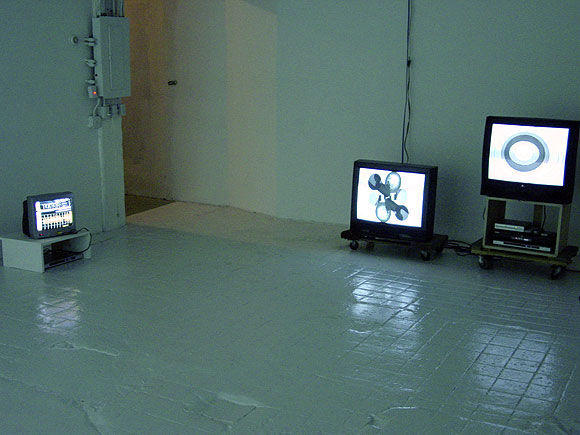
Farhad "Conspiracy? What Conspiracy?" Manjoo, fresh from efforts to prove that Robert Kennedy, Jr. and the rest of us are just way too overwrought about the 2004 election results in Ohio, now turns his debunking eye to the 9/11 conspiracy wackos (in Salon today--probably behind the subscription firewall). The subject is Dylan Avery's popular film Loose Change, but Manjoo makes sure to interview some other nuts so we can all have a good laugh about Satan being behind the plot, etc. At the end he includes a quote from 9/11 Commission member Bob Kerrey that's actually substantive:
Kerrey was dismissive of the conspiracy theories as well. Asked about the possibility of a controlled demolition at the World Trade Center, he scoffed, "There's no evidence for that." But he also noted that, quite apart from what Avery and others in the "truth movement" have proposed, many legitimate mysteries still surround the events of that day. "There are ample reasons to suspect that there may be some alternative to what we outlined in our version," Kerrey said. The commission had limited time and limited resources to pursue its investigation, and its access to key documents and witnesses was fettered by the administration. "I didn't read a single PDB," Kerrey said, referring to the president's daily intelligence briefing reports. "We didn't have access to Khalid Shaikh Mohammed," the mastermind of the plot. "We accepted a compromise, submitting our questions to him through the CIA. Now, that's not the best way to go about getting your questions answered. So I'm 100 percent certain that [bin Laden] directed that attack, but am I completely comfortable saying there was no direct Saudi involvement, or that Saddam Hussein wasn't involved in some fashion, or that the Iranians weren't involved? I'm pretty close to 100 percent certain, but I'd be more comfortable if we'd interviewed Khalid Shaikh Mohammed."I'm sleeping a lot better now, knowing how thorough the investigation was.
Just watched the trailer for A Scanner Darkly. It looks like an extended episode of Tom Goes to the Mayor. I'll see it out of loyalty to Phil Dick and the desire to hear his excellent words spoken by actors such as Robert Downey Jr. But there's a reason we had to wait twenty five years for a definitive Lord of the Rings--it took that long for the stink to clear from the '78 Ralph Bakshi version, which also showcased rotoscoped animation.
A fairly nuanced article from Cory Doctorow in support of "net neutrality" is here. He makes hash of the phone companies' beef that internet companies are getting to "use their pipes for free," but at the same time lists the difficulties in crafting neutrality legislation that doesn't stifle future innovation. Here's a good way of understanding what's at stake in the argument, and why you the consumer should care about the issue:
Why does network neutrality need protecting? Craigslist co-founder Craig Newmark addressed this point in an editorial he wrote for CNN.com: "Let's say you call Joe's Pizza, and the first thing you hear is a message saying you'll be connected in a minute or two, but if you want, you can be connected to Pizza Hut right away. That's not fair, right? You called Joe's and want some Joe's pizza."Make no mistake, our phone and cable companies are spending millions and working Capitol Hill to take away some of the freedom you currently enjoy with the Internet. They hate it and want you to subscribe to their shitty programming the way you do with cable TV. On the other hand:
The most prominent voices for net neutrality have been calling for a regulatory solution. Regulation created this mess, so maybe regulation can solve it. Congress can pass a law directing the FCC to adopt rules to ensure neutrality.Read the rest, it's interesting, if complicated. I don't think we can just throw up our hands and say "the big companies will take care of this." Citizen involvement--Net user involvement--is going to be needed at every stage of the process.
It's a plausible answer, but the devil is in the details. If we're going to come up with regulations to keep the phone companies in line, we'll need to be sure they do the job. That means:
* The regulation should only catch companies when the free market and competition fail to protect customers. The long-distance fiber market, for example, has proven to be quite amenable to competition, as has the local ISP business. The rule has to be for the last mile, and only the last mile, whether delivered by wires or wireless.
* The rules should keep the phone companies in check without screwing the next generation of network services. Overlay carriers like FON, who provide last-mile connectivity by piggy-backing on the carriers' networks, should be free to play around with business models. This is about protecting us from monopolies in the last mile, not locking them in as the only last mile we'll ever get. We want to leash the Bells, not new innovators.

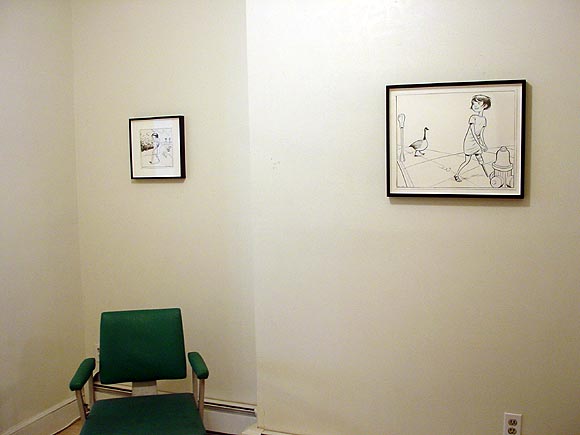
Dado used the image of the TV static photos I did (with Ray Rapp) to accompany a blog post on the buzzing sounds and visual crackling we sometimes experience in sleep or near-sleep, and their relationship to the "three types of thought": perceptual, linguistic, and proprioceptive (involving body awareness). It's in French, so I'm relying on Google to translate it. I'm pleased to see the image getting out there. That work has not been shown, outside my studio, website, and the people who have linked to it. Or, put another way, it has been shown around the world but not seen in a physical, public space in New York.
A few weeks back I noted the similarity of our Pres to Paul Lazzaro, the character in Kurt Vonnegut's Slaughterhouse Five who lives for revenge (played by Ron Liebman in the movie). Lazzaro describes cruelly killing a dog who bit him once, biding his time and waiting for the right moment when the animal "least expects it." Eventually Lazzaro whacks the book's protagonist, Billy Pilgrim, as payback for some ancient slight. Bush offers nothing positive or constructive as a leader but excels at settling scores, Saddam being the most conspicuous "because he tried to kill my dad at one time." Recently blogger Elton Beard made the Lazzaro connection too, and even found a similarity in language used by George and Paul:
Q: Mr. President, what do you think of the successor to Zarqawi that was named by al Qaeda? ...THE PRESIDENT: I think the successor to Zarqawi is going to be on our list to bring to justice.Now, it's one thing to relinquish without fight a fragment of language like "begging the question" which is at least arguably only of interest to logicians. But if "to bring to justice" comes to be commonly understood as "to kill on my command" rather than as "to try before a duly constituted court" then it seems something crucial will have been lost.
* * * * * *
Speaking of killers - readers of Vonnegut will no doubt also appreciate Mr. Bush's fine impersonation of Paul Lazzaro from Schlachthof Funf:LAZZARO: You're on my list, pal.Paul Lazzaro lovingly maintained a list of people he disfavored and consequently planned to kill. He was, of course, quite insane.
David Lynch asks a WTC 7 related question (Quicktime). Go David!
Click it today* because it's his daily report and the question probably won't be up tomorrow.
*("Friday, June 23. Here in LA we have blue skies, golden sunshine...")
Update, Jun 26: Here's what he asked on Friday: "An interesting question for the blog page: Do you think all high rise buildings should be condemned? Because as was proven with for instance the WTC 7 building in New York, if a few floors catch on fire, the whole building falls down. Do you therefore think all high rise buildings should be condemned?"
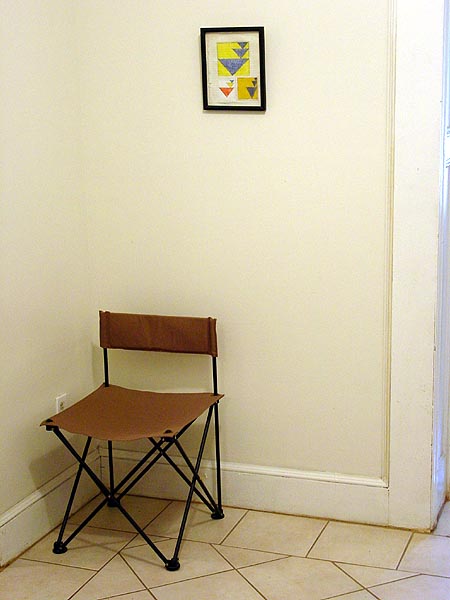
"Piano Three Hands (Drums)" [mp3 removed]
I posted this tune a while back as an "acoustic piano" piece. [mp3 removed] A friend was nice to compare it to Conlon Nancarrow, who laboriously wrote music on real piano rolls to be played by real player pianos.
That's encouraging, but I'm not as atonal or obsessive as CN. I was actually imagining some kind of "dazzling" Keith Emerson/Wyndham Hill solo played without any emotional expression. The crowd-pleasing speed and key-modulating complexity without the ladled-on passion we expect from keyboard virtuosos.
Here, I took the same tune and added drums and changed the piano samples to more of a "house" sound. Now it could be a MIDI version of Yellow Magic Orchestra, or at the very least, not Nancarrow. The point here, if I have one, is that our associations of music depend largely on the instruments used rather than structure.
This one's more fun, I think.
If you liked the video of racing police cars I posted last week you might also like this YouTube clip depicting a deck being torn off a rustic cabin. [via schwarz].
"Our Rulers From Space" [mp3 removed]
The weird effects are mostly the AdrenaLinn II, a beat-synched filter FX box. A kind of '50s "Mars Attacks" vibe crept in.
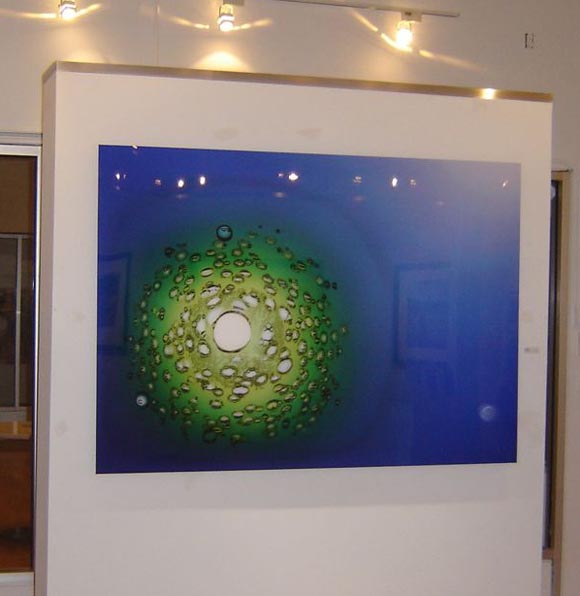
John Zoller, Alphamega 8, 48 x 70 inches, laser light print, at the APG Gallery, Atlanta, GA. Zoller's "Alphamega" series is "non camera based photography" created with fire on photo emulsion and without any digital manipulation--an old school FX approach, although I'm not aware of anyone who did anything quite like this. It's a bit reminiscent of the Joshua White gelatin/food color/Pyrex dish/overhead projector school of psychedelic light show (pre-laser shows) gone all rigorous and formally elegant. The multifaceted Zoller (a New Yorker now living in Fla.) also did the "United States: Color and Learn" painting series I've posted a few examples of. Below: detail of Alphamega 3.

Sally McKay has documentation up of the "Mods & Rockers" show she curated for Digifest 2006 at Harbourfront Centre in Toronto (on view through July 9). A few posts back I ran some pics of kids looking at the part of the installation I collaborated on with John Parker. Below are some pics from Sally that give the overall layout of the show. There are 8 "display windows," each with video capability and divided into pairs. Each of the four participating artist teams (consisting of one Mod and one Rocker) was assigned a pair of display windows. Headphones common to each pair of windows played audio from a single sound source. John and I opted to have the videos running independently from each other--both are looping, "steady state," psychedelically flavored digital abstractions (documented earlier here ). The audio (documented here) is a tune we jointly composed, with the idea in mind that it would generally "go" with the videos without being in sync with them-- thematically, as well as with random rhythmic and melodic correspondences the viewer could potentially experience. Our installation seems to work as a stand-alone piece (based on the feedback I've had from Toronto) but it is also a "digital non-site" in that the various stages of it, our experimentation and thought process, frames, fragments, sound bites, false starts, and "tech content," were documented on this blog and John's website. The subject matter one viewer kindly described as "full on digital." This is from our statement:
Rather than have some kind of face-off, or rumble, we are merging sensibilities. The collective inner Mod is the high tech influence in the form of some sophisticated audio software and a newish laptop used to edit and burn the video, and the inner Rocker is the low tech source material: 8-Bit-style tunes on an old Mac (some originally composed in the '80s) and animated GIFs by Tom based on MSPaint versions of Web images of John's work.
We're trying for some sort of parity between the audio and visual material. Pixels and square waves are both medium and subject.
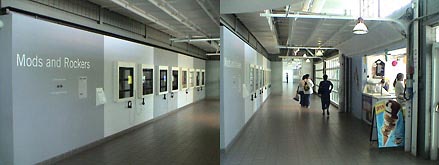

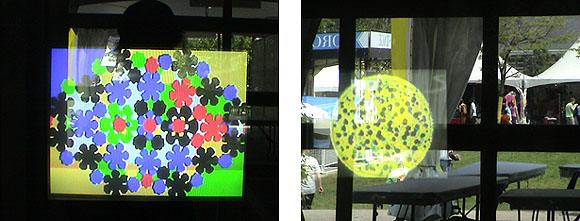
It's been fun knowing you all on the Internet, but the party's coming to an end unless we start lighting up the phones at Congress.
What Would a Non-Neutral Internet Look Like?Excerpts of a debate between an amazon exec and Telco spokesman/hack Mike McCurry here.
by Matt Stoller, Mon Jun 19, 2006 at 01:18:36 PM EST
Ok, it's March, 2008. You go to your computer and open your Verizon-supertier browser, and everything comes at you with blazing speed. You access your bank, NBC news, Andrew Sullivan's blog through Time.com, and check your email. You watch the last five minutes of Scary Movie 7, which you fell asleep watching the night before. Pretty cool.
Then you remember your best friend set up a new blog about her band and asked you to check it out. It's kind of irritating, because she set it up on the slow tier. You minimize the Verizon browser, open up Firefox, and type in the web address. It takes thirty seconds to load. Ugh. The site's fine, and there are some cute pictures of her band performing in a dive bar. You click on a song, and the browser begins loading the first minute of the song. After twenty seconds, you curse the fact that she didn't pay to be on Verizon's internet, and you close the browser. You're even thinking of canceling your slow-tier internet account, since shelling out the $45/month for that plus the $29/month for Verizon super-tier isn't worth it.
Welcome to a non-neutral internet.
--------
The net neutrality fight is coming to the Senate this week, with the Commerce Committee set to mark up the bill on Thursday. If you live in one of these states, call your Senator. We need strong net neutrality provisions in any telecom reform bill, and those that came out in the second draft over the weekend are not acceptable.
Chairman Ted Stevens (AK), (202) 224-3004
John McCain (AZ), (202) 224-2235
Conrad Burns (MT), Main: 202-224-2644
Trent Lott (MS), (202) 224-6253
Kay Bailey Hutchison (TX), 202-224-5922
Gordon H. Smith (OR), 202.224.3753
John Ensign (NV), (202) 224-6244
George Allen (VA), (202) 224-4024
John E. Sununu (NH), (202) 224-2841
Jim DeMint (SC), 202-224-6121
David Vitter (LA),(202) 224-4623
Co-Chairman Daniel K. Inouye (HI), 202-224-3934
John D. Rockefeller (WV), (202) 224-6472
John F. Kerry (MA), (202) 224-2742
Barbara Boxer (CA), (202) 224-3553
Bill Nelson (FL), 202-224-5274
Maria Cantwell (WA), 202-224-3441
Frank R. Lautenberg (NJ), (202) 224-3224
E. Benjamin Nelson (NE), (202) 224-6551
Mark Pryor (AR), (202) 224-2353
"Its a political fantasy world and unless you're in the Tolkien family, those worlds end and end badly."
From Steve Gilliard:
You know, I sit back, watching the news media and consultants shit their pants over Kos and I have to laugh. They're worried if Warner has too much influence, why they don't like Hillary Clinton, why does he have such influence. They're dragging the party to the Bush-hating far left.Update: Speaking of Counterpunch, co-editor Alexander Cockburn has a few choice words about lefty bloggers.
They just don't get it.
Bush-hating? I can introduce you to some widows and Gold Star Mothers who hate Bush with a white hot flame, who are not from the Sheehan and Berg families.
Far left? Uh, Counterpunch is that way.
That's not the issue here. Those are just cheap terms by scared people.
If they had a clue, they would realize that Kos is just the pointman for a lot of extremly unhappy people, and that efforts to diminish him is well, pointless. Because he's not the issue, it's his site, and his site can be replaced. But what's behind that site can't be.
The right and the media were just fucking jealous at Yearly Kos, looking to pull it apart because the peasants have entered the room. How dare they have big parties, they aren't consultants.
No, they're average people who are no longer apathetic and don't like what they see in politics No more bitching to friends, no more whining to the spouse. They can get involved and make a difference. And that's a gift to this democracy. It may not seem it on K Street, but Bush is a petty, Oedipal man, driven to succeed over the bodies of the dead. He will fail, and when he fails, the odds of the 25th Amendment coming into play increases exponentially.
We cannot continue with politics as usual, because it's the politics of denial. We deny the truth about everything around us and act shocked when it doesn't work out. Health care, no problem, Iraq, no problems, dependent on immigrant labor, no we aren't, ship them back. Sex tell them no.
Its a political fantasy world and unless you're in the Tolkien family, those worlds end and end badly. We will be coming to account and it won't be pretty.
So what happens, you have the whiny-ass titty babies like Jake Tapper whining about Media Matters, and the breck girl of the right, Byron York wondering if Kos is on the pad.
Let me send this message to the consultant class right now, the right will miss it. You do not have to worry about Kos, Atrios, Matt Stoller or anyone else, certainly not me. We are not your problem. It's enough to control what's posted to our blogs on a daily basis.
Our readers, otoh, are a different story. They hate you, they would like nothing better than to drive you from business and into penury. They would hunt you down like dogs and seize your homes. They blame you for ruining America. Bloggers are just conduits for the feelings of lots of people. You confuse the two at your peril. Anyone who thinks our readers are docile slaves, well, they're nuts. They can challenge us like it was a sport. Parse our words like lawyers. And you can never tell what will drive someone nuts.
Piss them off and you've got a problem. We know, we've all done it. Kos has been the scene of nasty fights, same with most sites. Our readers hold us accountable in a way which would make Jake Tapper cry.
It was the readers who propelled the Lamont bid, not the blogs. At best, we're pointmen for a lot of ordinary people. People forget that at their peril.
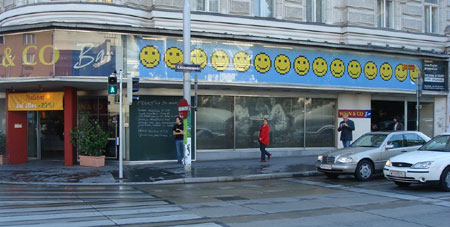
Cory Arcangel: "In collaboration with Galerie Lisa Ruyter and the museum in progress, I have placed a horizontal rule of gif smilies onto the Wein & Co building in Vienna..."
From the museum in progress website: "Cory Arcangel's stripe is based on 'horizontal rules,' horizontal lines of images which were common for early webpage designers to divide their webpages horizontally."
That's the front story and the back story. How many people walking down the street in Vienna will recognize that line of smileys as kitsch from the early vernacular web, to use Olia Lialina's phrase? I don't care--I like the utter banality of this piece whatever the viewer gets from it. I'm guessing it's invisible to the passerby, and there's something really beautiful about that. On the other hand, maybe it has a slightly alien quality that makes it pop (that's a verb) out there on the street. That's the curse of reacting to work from secondhand sources: we just don't know.
Update: For the Lisa Ruyter referred to in this post see Francis Ruyter.

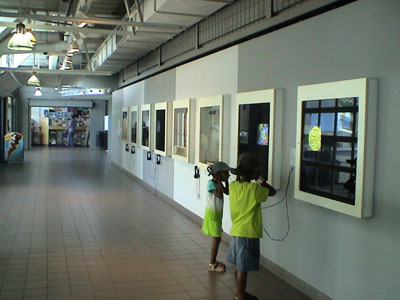
Young art consumers viewing the collaboration I did in Toronto with John Parker. The exhibition is "Mods & Rockers." The videos are documented here and the audio is here.
"Suite 6 (Almost Live)" [mp3 removed]. An older tune I had adapted for a live playing situation when I did my lecture/performance on May 19. It's "rougher" in that the Sidstation gets glitchy when you change patches and turn knobs aggressively. In doing a studio version of the live version (of the studio version) I did some overdubbing, but it still has more of a live feel of egotistical musicians stepping on each other.
An important factoid omitted from my talk (because I just learned it)--the company that makes the drum machine (Vermona/HDB) used to be the state synthesizer company of the former East Germany.
The interview Paddy Johnson did with Michael Bell-Smith and me has concluded, but I want to address one point Mike raised at the end, so I'm carrying the discussion over to my page. The other participants have blogs and can do the same.
MBS: [...] The work in the [Foxy Production] show was created with a gallery in mind and I wanted it to feel that way. Rather than playing off the tensions of bringing new media into the gallery - as I feel Tom has with his show – I wanted it to feel like a natural fit, again, like maybe this is just how we make art these days.
I don’t think flat screens in a gallery feel especially high tech. For me they’re less loaded than traditional TVs/monitors (which feel consciously lo-tech), high end CRT NTSC monitors (which tie into a history of video art in the gallery) or large projections (which feel cinematic or as Tom pointed out, aggressive).
For me, the containment of wall-mounted flat screen monitors is about putting the work on a physical and spatial par with painting, drawing or photography. I think creating that kind of familiar physical relationship between the viewer and the work may serve to combat the tech gap: at the very least the viewer knows how to deal with the piece on a physical level. [...]
TM: These are good points. I want to add that, although I recently did a blog post called "Showing new media work in a gallery: what's at stake," that isn't the main content of my show, any more than Mike's content was his delivery system. The gear I used is to deliver the strongest statement--which is to say, to get the most out of the pulsing abstractions, repurposing of a Star Trek sensor as a "simulacratracker" (as one commenter described it), and the embarassing acting out (or faux acting out) of Guitar Solo (which actually is on a tiny flat screen). I've argued with a couple of people about my use of tube TVs instead of LCDs for three of the pieces. I chose the tubes because they deliver a punchy image, punchier to me than what I'm seeing on flats these days. Tubes aren't that "retro"--J&R Music and Video still has a wall of CRTs for sale as an alternative to the wall of LCDs. I know, it won't last, but we're talking about the present. Translating animated GIFs from a computer to a single dedicated image on a TV adds an element of the unexpected, and a gritty texture I like. These choices aren't just to emphasize "new media in the gallery"--although that's definitely an aspect of the content.
One of my recent "out and about" pics is the Photo of the Week on NewMusicBox, the website of the American Music Center. Thanks to Molly Sheridan for the linkage.
"It's a number."
Here was the interchange with the White House press secretary after the number of Americans who died fighting the Cheney Administration's war of choice, against a country that did not theaten us, passed the 2,500 mark:
Q Tony, American deaths in Iraq have reached 2,500. Is there any response or reaction from the President on that?There really aren't words for how monstrous these people are. Not "the troops"--the people who needlessly put them in harm's way and justify their continued slaughter with this weak BS. To say nothing of the Iraqi civilian casualties, which the most conservative estimates put at an insane 38,000 to 42,000.
MR. SNOW: It's a number, and every time there's one of these 500 benchmarks people want something. The President would like the war to be over now. Everybody would like the war to be over now. And the one thing that we saw in Iraq this week is further testimony to the quality of the men and the women who are doing that, and the dedication and determination to try to ensure that the people of Iraq really do live in a free, effective democracy of their own creation and design.
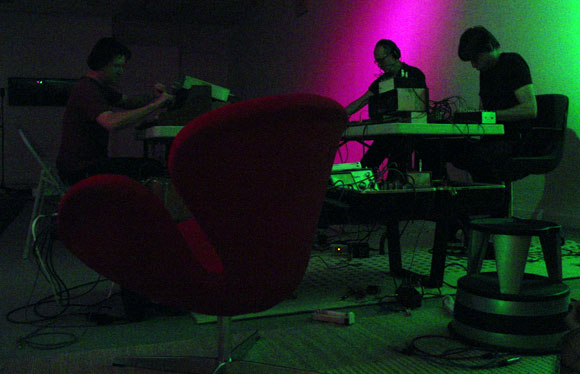
Photos taken last night at Analogos, a program of all analog, abstract synth music at Diapason, on 6th Avenue. The program was billed as "a night of 'vintage' (and other) analog synthesis." Above, left to right: Michael J. Schumacher (Steiner-Parker Synthacon); Ed Tomney (EMS VCS3 "Putney," various), and David Galbraith (selfbuilt electronics). Performing but not pictured: Tom Hamilton (Sherman Filterbank). The piece they're playing conjured electronic jungle birds morphing into synthetic clattering traffic sounds; the perfomers listened attentively to each other as these moods changed, or so it seemed from where I was sitting. Also nice was a duet between Galbraith and Hamilton where the output from the former's homemade synth circuitry was fed live through the latter's filtering apparatus--a subtle, somewhat lyrical piece. A later trio between Tomney, Schumacher, and James Fei on Buchla synth was like being inside a tornado, with airborne Geiger counters zizzing around. (If I'm not mistaken it was the VCS3 producing those sublime hypnotic swooshing sounds.) And finally, a duet between Barry Weisblat (pictured below with homemade electronics) and Kato Hideki on Octave "Cat" synth and pedals provided the evening's rock and roll skronk notes, as Hideki "got down." This was a great evening, some beautiful, dense textures and not a MIDI clock to be heard--it was all voltages providing the rhythms.
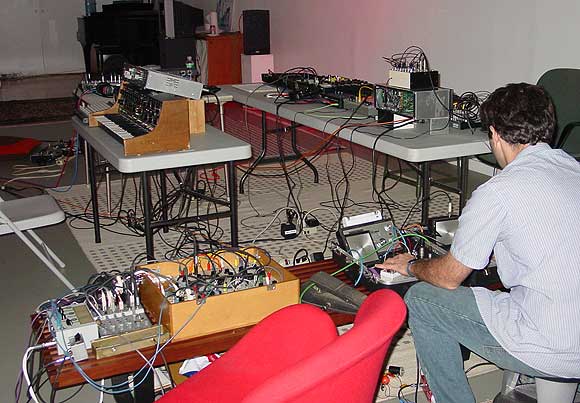
"Your Haploid Heart"
Fascinating article in Bookforum about CIA employee Alice Sheldon, who wrote science fiction under the name James Tiptree, Jr. The essay, discussing a recent bio by Julie Phillips, connects the themes of Tiptree's fiction to Sheldon's early life as the daughter of a writer/explorer traveling in Africa and Asia. I've only read one Tiptree story and didn't like it much but the story of her double life is intriguing, particularly the way political themes that could never been expressed in her "day job" got worked out in her fiction. It would be interesting to compare Tiptree's work to that of Paul Linebarger, another DC spook-type who wrote SF (as Cordwainer Smith). Sheldon was a Star Trek fan and I like this passage from the review:
"It was partly from colonial adventure stories like [Sheldon's mother's] that science fiction was born," Phillips observes. "The first time Alice saw Star Trek, she recognized it at once as a story about her childhood." This observation, like so many in this superb biography, strikes deep. It illuminates one of the darker corners of science fiction—its political unconscious, as it were. The writer's bible for Star Trek couldn't be clearer about the colonial echo: "Horatio Hornblower in space." The multicultural crew may look like it's been sent by the United Nations, but its gunship could wipe out a planet.But what about the Prime Directive? One thing I didn't know about Sheldon's life was how it ended. She feared aging and caring for a husband twelve years her senior, so they had a "suicide pact" in 1987 that the review suggests might have been a murder/suicide (Sheldon shot him and then herself). But her fiction seems every bit as renegade and "difficult" as that juicy story--I'm now eager to read more of it.
The early story "Your Haploid Heart" combines the love-death theme with another one of Tiptree's obsessions: the willingness of rational beings to exterminate "inferior" races in the name of progress. Representatives of the Galactic Federation have come to see if aliens they contacted generations ago qualify for admission to the Federation. Only "human" races do. It's the same question that preoccupied nineteenth-century colonialists: Are the natives human? The Federation's definition of human is sexual; if a race can interbreed with humans, it is human. The Esthaans are so eager to be accepted that ever since first contact with the Federation they've hidden a dirty secret—the inferior Flenni race that dwells on their planet. In truth, the Esthaans reproduce like mosses: They bud asexually to produce sexually active offspring, the Flenni, who are in turn the parents of the Esthaans (and who are, in fact, sexually compatible with humans). This biological fact is so inconvenient and repulsive to Esthaan ambitions that it has been repressed, and the Esthaans are on the verge of exterminating the Flenni, even though the consequences would be suicidal. Once again, the armature of this story is standard-issue SF—a single scientific fact, in this case the diploid-haploid reproductive cycle, is extrapolated, and its consequences drive the plot. But the depiction of psychosexual madness is an exceptional departure from the genre's norms. And a further barb: This lunacy was brought by the Federation with its offer, Be like us.Below, detail of a portrait of Alice Sheldon by Patti Perret, from The Faces of Science Fiction, 1984:
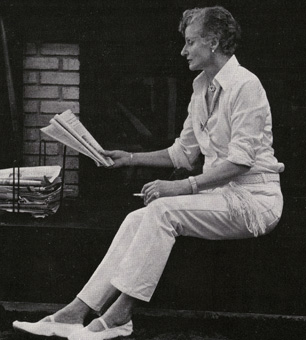
Part Three of Paddy Johnson's interview with Michael Bell-Smith and me is here. Here's an excerpt, slightly editorially massaged to reflect a clarification of terminology later in the interview:
[Michael Bell-Smith]: For many people (techies and lay folk alike) issues of authenticity and technique are on the surface of all digital work. Digital is akin to magic: the magic of the desktop computer, the magic of cinema special fx, the magic of the internet, and with that magic - what Tom [is calling] the "tech gap" - is often skepticism and anxiety. One way I try to counter that gap is [via] lo-res graphics, basic movement, slow pacing. (Up and Away, for instance, from a mechanical standpoint, is no more than a series of still images moving from the top of the screen to the bottom.)Meanwhile, in this comment thread, we've been batting around a "movement name" for "recent developments in net art/new media that are making small incursions into the gallery art world." We have some good trial balloons; eventually I'll summarize them. Contributions are welcome--please add them to the thread.
It's an attempt at letting the seams show, a step towards the folk art approach that the artist drx (by way of Tom) has advocated. My hope is that an audience might have a better understanding of "what's going on" and can therefore engage the work from other angles.
A nice side effect of this, is that once you begin to suss out what's going on, you might begin to think about other forms of digital mediation in your life, and wonder how those work, and wonder if you've ever seen their seams, and if not, why not?
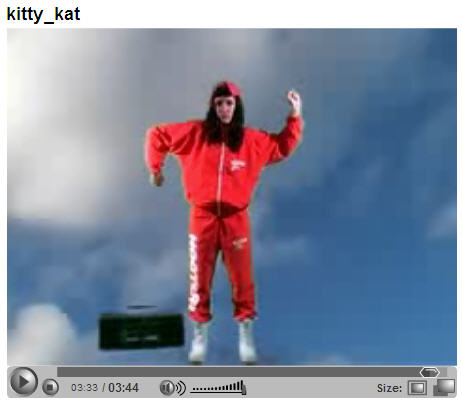
Frankie Martin, "kitty_kat" [YouTube]. Dorky and lascivious. I like the scrolling urban backgrounds inhabiting different perspective spaces from the foregrounds, the cat wallpaper, the exquisite Naughty by Nature song, and....the hot women in cat costumes.
Update, 2011: The video was removed from YouTube on "copyright grounds."
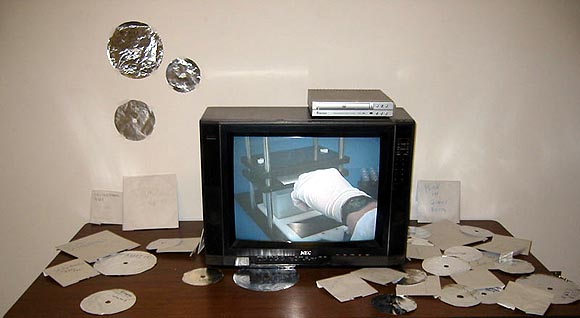
Some new Guthrie Lonergan videos here. Above is how these YouTube-friendly works were displayed in "real space"--surrounded by tinfoil DVDs and CDs. The videos have a powerful mood--it's Lonergan's original music, and the matter-of-fact way they're put together. The "office party" one almost makes me cry. I think office stuff is important content right now--it's one ethnographic Other the art world can't face and doesn't want to celebrate and assimilate the way it has every other exotic culture. The depressing environment from whence cometh the bacon of the owner class. Signed, Karl Marx Jr.
Below, more Internet content reified and cargo-culted into the physical world. A couple of Lonergan web pages saved via a screen cap program and made into collages. The one on the left is Halt, Robot!, his collection of bot-deterring "read me before you can post" typography, mostly from MySpace. The web page the collage on the right is based on hasn't been posted yet. I like the craft project vibe of these pieces.
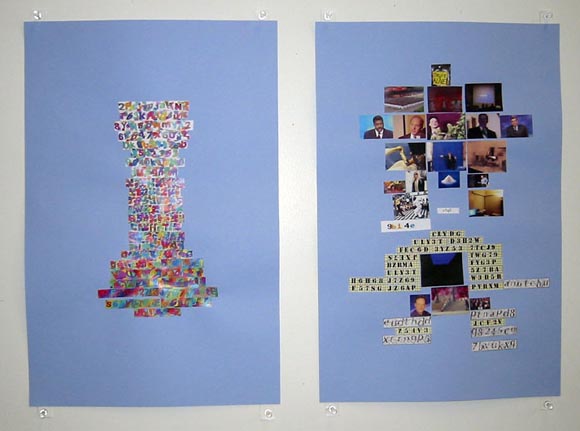
Lonergan has also been collecting MySpace intros. I really don't know how to talk about this work. I feel a bit like James Stewart in Rear Window watching these normal people doing their awkward and occasionally very funny home movie bits to introduce themselves to a million total strangers. It's completely public domain but feels invasive somehow.
NYPD Surge Drill
Velvet Sea: "Today in Chelsea, the NYPD conducted another surge drill, where they send a boatload of cars streaming to a single location in a massive show of force, scaring half the city into thinking that something horrible has actually happened. But alas it's just a drill--I think. Check out the video--this was one of four groups of cars that surged past one after the next." [YouTube]
Part two of Paddy Johnson's interview with Michael Bell-Smith and me is up. Part one is here. A side discussion is continuing here.
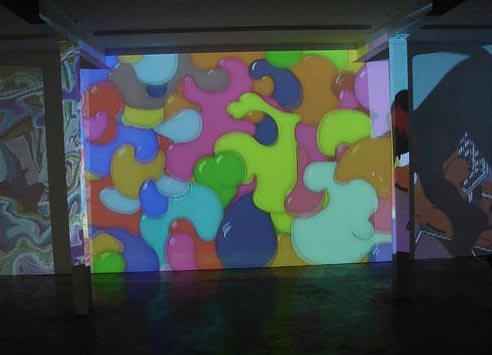
Continuing on the topic of "showing new media art in the gallery": Pierre took the terrific installation shot above of Takeshi Murata's work (the image is on Pierre's flickr page with commentary here), at Vilma Gold Gallery in London. The exhibit was "Take it to the Net," curated by Hanne Mugaas, which included Murata, Michael Bell-Smith, Seth Price, Paper Rad, Paul Davis (Beige), Thomas Barbey, and Jean Baptiste Bayle. I'm curious to know more about this piece. Would I like it less in person? More? What is its "net art equivalent"? Does it have one?
Update: More installation photos of "Take it to the Net" here.
"Speed Too" (Sandra Bullock Dance Party Remix) [mp3 removed]
An alternate take of a collaboration I did with with John Parker. This is a bit longer and more substantially produced than the version we sent to Toronto for the "Mods and Rockers" installation (which needed to be grittier to go with the videos).
"Each pattern has the maximum complexity and 'resonance' for the minimum number of frames."
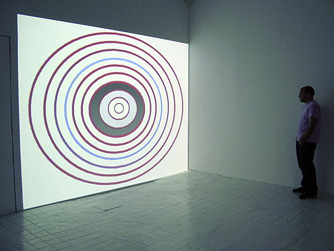 Paddy Johnson is interviewing me and Michael Bell-Smith this week about our shows; I hope you'll check it out.
Paddy Johnson is interviewing me and Michael Bell-Smith this week about our shows; I hope you'll check it out. "Geeks in the Gallery" is a three part discussion with artists Michael Bell-Smith and Tom Moody, which will run on Art Fag City from Monday June 12 – Wednesday, June 14, 2006. A recurring theme of the talk is how technology informs artistic production, as both artists have individually exhibited work usually described as New Media, yet also seem somewhat skeptical of "tech art." Moody’s "Room Sized Animated GIFs" at artMovingProjects in Brooklyn is comprised of animated GIFs projected or displayed on variable sized CRT monitors/tube televisions, plus a looping movie of the artist performing a computer-fabricated (but realistic-sounding) "guitar solo." The show dates are May 5th – June 25, 2006; it can also be viewed online on the artist's site. Bell-Smith's exhibit "Focused, Forward" closed last week at Foxy Production Gallery and included digital animations steeped in the aesthetics of '80s and '90s video games, a print depicting collaged patterns that create a virtual Tower of Babel, and a game table-like video sculpture with a simulated radar graph of birds circling over the White House. Show dates were April 27 – June 3, 2006; it can be viewed online at foxyproduction.com. [...]Some thoughful comments were made in response to my "preview remarks" about the interview and the general topic of "showing new media art in the gallery." I've replied to a couple of those, in the comment(s) to this post--anyone is welcome to chime in about that ongoing thread or the interview.
L.N.R., reBlogging at Eyebeam, makes the observation about the preview remarks: "Self indulgent, but interesting questions."
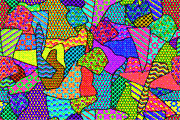


Curbed keeps us abreast of all the horrible "luxury condos" going up in the New York metropolitan area, has interesting views of things happening on the street (like the eviscerated rabbit in a block of ice found in Union Square), and great photo captions. "Jeremy's" are frequently on the money. This one reads "My architect assured me the changes had been made."

"Showing new media work in the gallery": what's at stake.
I have been working on a marathon interview that will be posted on the interviewer's site soon. The subject, more or less, is "showing new media work in the gallery," centering on my and another artist's current shows, and the interview has become like this insane Fluxus event where new information keeps surfacing and the dialogue goes on and on. I think it will be enjoyable to read, for all that.
I was talking to the interviewer yesterday and we uncovered more broad swaths of things that could have been said. Here's a summary of some of those items, before I forget, plus some stuff I just thought of.
1. The "tech discussion" is boring but there are some fundamental things that need to be covered. Specifically, what similarities exist between art and design in the web/computer environment and aesthetic principles of the art world. In the interview we talked some about the differences between the remixology/upload/download culture of the internet and the art world's need for defined, specific objects that can be shown in real space. My comments below are mostly about the similarities in the form of "minimalist" sensibilities common to the art and geek worlds.
2. Design consultant/philosopher/guru Edward Tufte talks about the need to reduce elements (in charts, etc) for maximum clarity and information flow. The minimalist sensibility in the art world talks about unnecessary gestures and ornamentation and "truth to materials" used to make art.
3. Software (e.g. Windows, Adobe) that is cluttered with unnecessary bells and whistles and extraneous lines of code is not beautiful or good. The "hacker aesthetic" seeks to remove this clutter (in Linux, Firefox, etc) so that users have more control over their lives.
4. Conceptualism in art also seeks to peel back the control mechanisms, to dismantle or parse the aura of the white cube and the mercantile systems underlying art (and therefore information) exchange.
5. In my case, my art is made in the simplest paint and GIF programs so I can eliminate some of the superfluous or overly controlling features of more "state of the art" software. Cory Arcangel and others have hacked even deeper--trusting only the numbers themselves under the graphic interfaces.
6. By putting the GIFs in the gallery (as videos), I'm making an immaterial art that is highly context dependent--depending on the shape of the room, lightness or darkness of walls and floor, and acoustics (for pieces with sound). I want the viewer to recognize the almost joke-like simplicity of the imagery (but not "overly simple," that's where the interviewer and I initially disagreed) and reflect on the mechanisms of the GIFs as well as the mechanisms of the white cube.
7. The other artist in the interview had similar goals but a very different approach, in that his presentation is more high tech and memory-intensive (even though his imagery is videogame-clunky), and the work is more absorbable into the gallery-collector-museum commodity stream by virtue of consisting of easily dispersable, physically portable pieces, with current hard drives, nice flat screen monitors etc..These "video-objects" will look pretty consistent everywhere they're shown, whereas mine change with the vagaries of available equipment and will be reconfigured on the fly for every space and hardware configuration. (Even though the underlying DVDs are offered for sale.) We never had a chance to really debate our different approaches, and I'm not sure we wanted to. Suffice it to say he has a better shot at posterity by meeting the commodity system halfway (as opposed to my quarter-way).
8. To sum up, the common (mostly unspoken) points of inquiry in the interview were: (i) what is the hacker aesthetic? (ii) what is the "gallery aesthetic"? (iii) how can these aesthetics be commingled? and most importantly, (iv) how can the viewer be made to understand these ideas just from viewing the work itself, without a podcast to explain it?
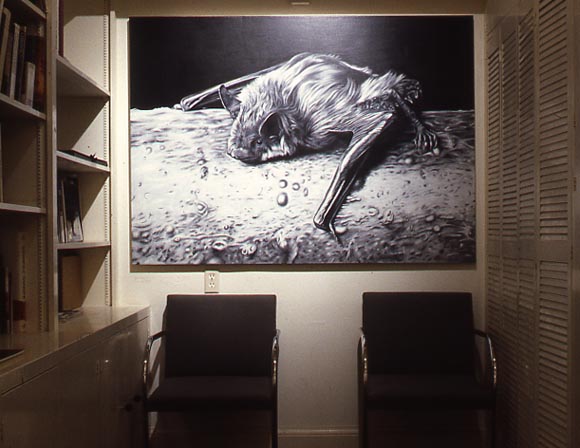
Large Bat, 1990, oil on canvas. The person who owned the gallery where I showed this was grossed out by it, but the gallery director liked it, so we hung it in her office during my show. I used to do a lot of photoreal-style paintings, many based on a book of copyright-free images called North American Mammals. (photo by Harrison Evans)
Cory Arcangel has created a web page with Kurt Cobain's suicide note that, when refreshed, pulls up different sets of Google Ads based on "keywords" in the letter. Pretty droll, and about says it all about our ad-annotated culture. I should say, so-called suicide note because, this being the first time I've read it, it sure didn't sound like he was planning to kill himself. More like, explaining why he was going to stop touring. As Paul notes, there is a conspiracy theory about the "suicide" that this note certain lends credence to.
"Piano Three Hands" [mp3 removed]. This will most likely be the first part of a longer work, posted in installments as I did with the string quartet piece a while back. The intro repeats at the end now, but I will probably take that out and add new material.
Update: Added an 18-second "middle section."

Bill Schwarz's 99 Bottles of Beer on the Wall begat Cady Noland, and Cady Noland begat...
Brooklyn-based artist Roy Stanfield, who has the most persuasive website of almost any artist whose work I've never seen, and whose drawings based on random Google image searches I posted about here. He's having a show at And/Or Gallery in Dallas, with Wendy Red Star.
Some photos of the show are here; the statement at the bottom of the page is very helpful.
The gallery's page documenting the show is here.
I'm being a bit cheeky about the website and all, but seriously, that is an inspiring series of photos documenting the artist's work. Almost no text is needed--with such a range of amusing, perplexing, and drop dead pretty installation shots (see the photos of skateboard ramps/swimming pools) the viewer supplies the back story and imagines radical exhibition scenarios that may or may not have happened. With its seamless mix of "exhibition space" and "environment" it is a thesis for an excellent career. Maybe I'll get to see the work in a New York gallery eventually.
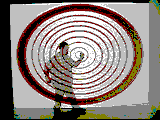
I know a lot of people watched CNN during the First Gulf War (the "good gulf war") and came to love the network's exciting style of round the clock reporting and showing that same clip of Saddam brandishing the shotgun over and over. I thought the network was just the lyin' propaganda arm of the government and I couldn't stand to watch it. Nothing's changed in 15 years. Here's a report from Salon's Tim Grieve:
Wait, you mean we didn't find any WMD?
From the "Earth to CNN" Department comes this Media Matters report on an otherworldly on-air exchange Thursday between CNN senior national correspondent John Roberts and CNN anchor Wolf Blitzer.
The subject was sanctions against Iran, and Roberts began by saying that the United States and its allies might not be able to get them through the U.N. Security Council. Fair enough. Then he said that sanctions don't always work. That's fair, too, and it might have been a good place to stop. Roberts kept going. "Don't forget," he said, "Iraq endured 11 years of sanctions, and, you know, we still had to go to war to get rid of what it was that they had."
Blitzer, who knows a thing or two about Iraq, immediately set Roberts straight, reminding him that the U.S. war against Iraq didn't, in fact "get rid of what it was that they had" because, as it turns out, they didn't have anything at all.
No, wait. That's not what Blitzer actually said.
What Blitzer actually said was, "Good point, John. Thank you very much."
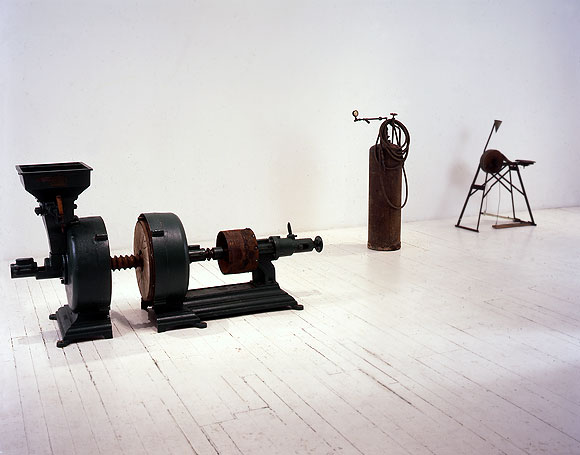
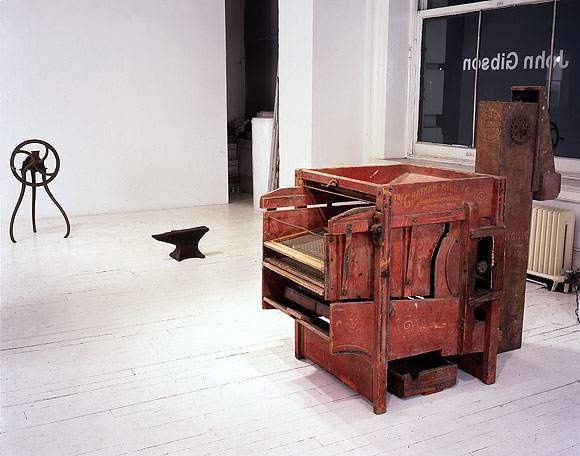
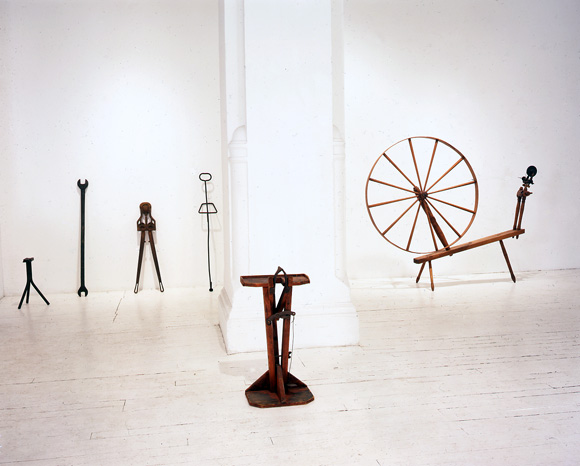
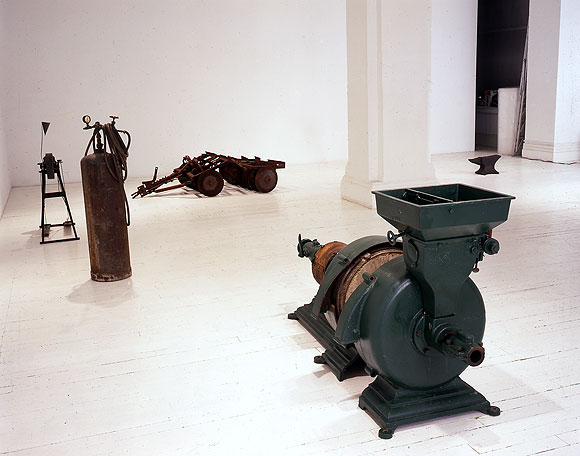
Bill Schwarz, installation views of solo show at John Gibson gallery, New York, 1995 (photos by Sylvie Ball). While the artist Cady Noland made urban detritus (machine parts, flags, key chains, beer cans) the focus of her found object/scatter installations, her contemporary Bill Schwarz, who was included in a number of Robert Nickas-curated shows around the time she was coming to prominence, took the more radical and I would say Robert Smithsonesque step of looking to the American heartland for appropriation subject matter. For this show at Gibson he trucked a selection of rusty, not-quite-obsolescent farm machinery into the white cube of the gallery and arranged it tastefully, a la MOMA curator Alfred Barr's "art of design" shows.
I say radical for a couple of reasons. In a way there's nothing more alien to a cosmopolitan New Yorker than these implements from red states, as we now call l them. Much of the equipment is obscure to the urbanite and seems completely divorced from function, yet is a matter of life and death to the (pre-agribusiness) farmer hacking a living out of the land. The exhibit follows the core principles of what Smithson called the "non-site"--a real place in the world transplanted into the white cube. The show is also "difficult" because of flirtation with kitsch far more threatening to refined urban sensibilities than Noland's Canal Street, dollar store ephemera: these battered, time-patinaed harrows and spinning wheels can be found all over the heartland tucked away in antique stores, used as flower pots, and so forth. The difference is the "Barr treatment" Schwarz gives them; the objects are arranged for maximum formal elegance, so that they resemble shows of mid-20th Century modernist sculpture, much as Barr arranged tools and machine parts, deliberately pointing up their affinities to Brancusi, the Cubists, et al.
The price of radicalism can be obscurity. The Gibson show was reviewed in Artforum and other publications but the work is not in museum collections. Now that we have the Net, it's possible for shows to be seen in a fleshed-out way that a back-of-the-mag Artforum review accompanied a single tiny picture could never convey. These images are completely relevant with Cady Noland back in the news, with the media attacking the "appropriators of the appropriator."
